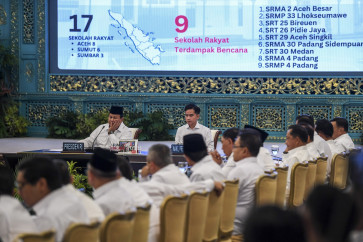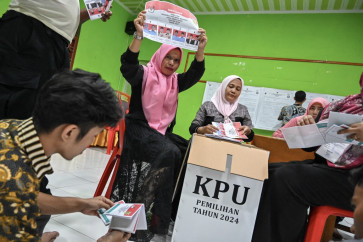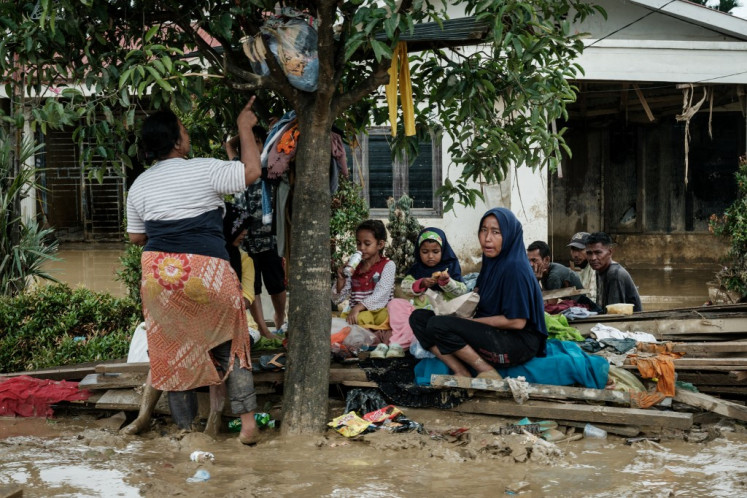Popular Reads
Top Results
Can't find what you're looking for?
View all search resultsPopular Reads
Top Results
Can't find what you're looking for?
View all search resultsPetrus Sugito: Cultivating seedless durians
Promising harvest: Petrus Sugito poses with the triple-stem durian tree he has developed
Change text size
Gift Premium Articles
to Anyone
Promising harvest: Petrus Sugito poses with the triple-stem durian tree he has developed. (Simon Sudarman)
A farmer from Yogyakarta is experimenting with the enhancement of the archipelago’s sweet, silky durian, which generally has big seeds.
Petrus Sugito, 60, has gained a reputation as a seasoned farmer with expertise in fruit-seedling cultivation. The farmer, who lives in the Menoreh Mountains in Kajoran, Kulonprogo, has been focusing on durian seedlings since 1986.
In his daily activity, Gito has been striving to create fruit seedlings with many superior features. In hastening the fruit-bearing time and increasing the number of fruits produced, he has finally cultivated a superior three-pronged durian seedling.
“With its three-pronged stem at the base, the tree grows faster and bears fruit earlier while it isn’t prone to falling. The seedlings of this triple-stem durian are much in demand for bearing sweeter fruit with thicker flesh,” said Gito, who sells the tree seedlings at Rp 250,000 (US$19) each.
Gito’s passion for durian seedlings earned him the Agriculture Ministry’s national certificate in 2007, which recognized his superior seedlings for two Kulonprogo durian varieties called the yellow Menoreh and the pink Menoreh. He also won the third-best national durian cultivator award in 2013 and snatched first place in Yogyakarta’s 2009 durian cultivator competition.
Nowadays, Gito is working on seedlings for a seedless durian, a new variety that, if successful, may become a tough competitor for imported durian like Thailand’s monthong.
“I’m convinced my dream of producing a seedless durian will come true despite the longer time needed,” said Gito, who studied durian seedling cultivation in Thailand in 2008 through the Yogyakarta Agriculture Agency.
Gito, who also learned about seedlings in Karanganyar and Salatiga, Central Java, estimated that it would take about 15 years to produce seedless durian seedlings. The process of reducing durian seeds to make them flat requires five to six generations of durian trees.
“The seeds remain but they’re considerably flattened so that the durian flesh will be thicker with more fruit,” he said.
Gito’s fruit seedling nurseries are located on a 1-hectare plot in the highlands, where he grows and markets citrus, avocado, guava and various other seedlings. Although he grows various fruit seedlings, he is better known as the creator of the local Kulonprogo durian seedlings.
The entire process of land preparation and fertilization makes use of compost or organic fertilizer, which costs little and can be easily found. Gito even makes his own organic pesticides to handle plant diseases.
Today, his organic farming provides him with fertile land, but it was not an overnight process. It took 15 years to apply this farming method, during which time he gradually minimized the use of any chemicals until he developed an entirely organic cultivation.
“But plant pests are growing in variety so I’ve got to keep experimenting with more effective organic pesticides. Fertile soil without disease makes seedlings vigorous and they grow faster in both dry and wet seasons, while organic cultivation ensures healthy fruit,” he said.
The grandfather-of-three believes that farmers should be able to communicate with nature and plants.
“In this way nature will care for us. Sadly, most people today have no time to do so and we even force nature to produce what is desired by men,” Gito lamented.
Assisted by seven employees, Gito has managed to boost his business so that his fruit seedling products have now been sold across the archipelago, including Jakarta, West Java, Central Java, Sumatra, Kalimantan, Sulawesi and as far as Papua.
“Actually I have to produce 10,000 durian seedlings in order to meet customer demand, but unfortunately, such a large number of seedlings requires more than Rp 150 million of capital,” he said.

Delicacy: Piles of durian are seen in Semarang, Central Java. Big cities like Jakarta and Semarang regularly hold festivals that celebrate this fruit. (Kompas.com)
Having so much experience in durian cultivation, Gito is more than happy to share his knowledge. The farmer who often speaks at seminars or workshops on durian seedling cultivation is frequently visited by other farmers from Cilacap and Bandung in West Java, Madiun in East Java, Sumatra, Kalimantan, Papua and other regions.
“I’ve got a great deal of knowledge with the help of many people, so I wish to share what I’ve achieved with those who need it, so the knowledge will be spread and more people will get the benefits,” he said.
His farm is also a place of research for university students, such as those from the Bogor Institute of Agriculture and Gadjah Mada University in Yogyakarta.
“Sometimes I am astonished. There are so many clever people out there, but they choose to learn from a farmer who only has an elementary school education,” Gito said, laughing.










